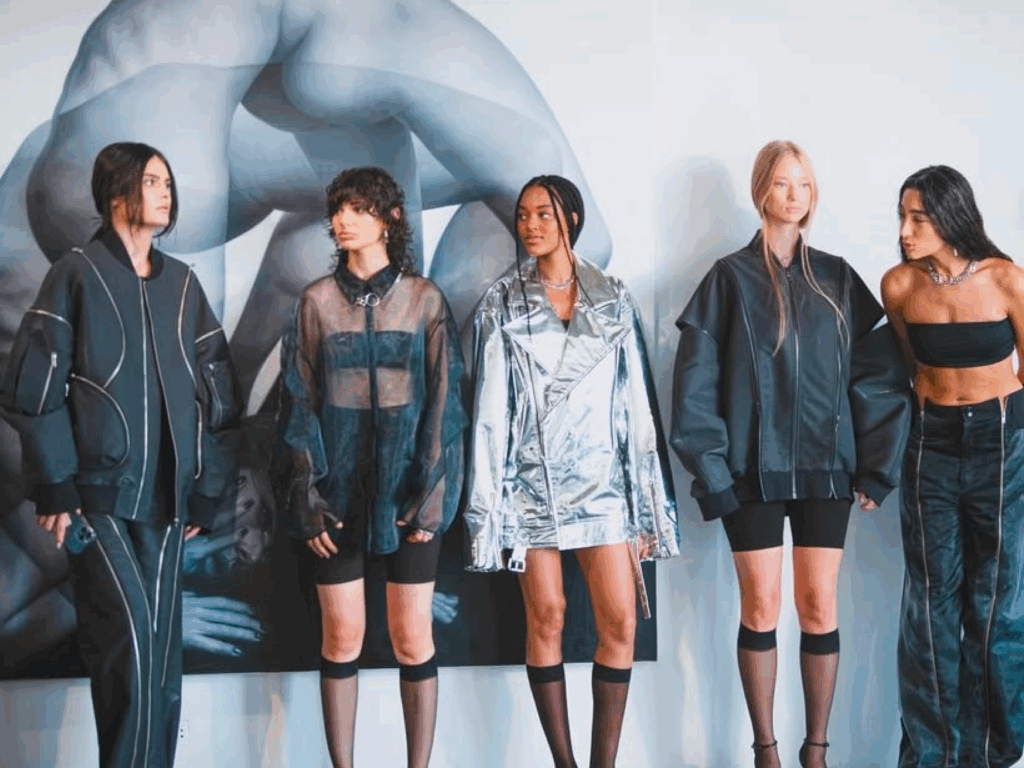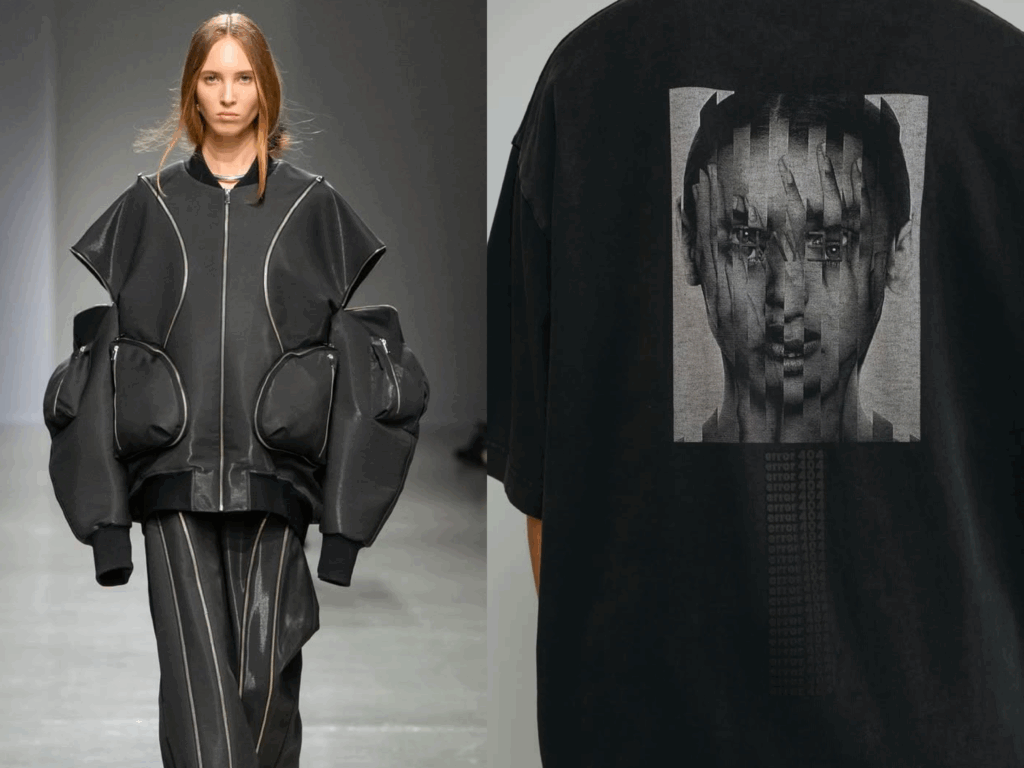Mirrors and Self-Isolation, his most celebrated series, are meditations on life and identity, reflecting on the human condition and our place in society. Now, Tigran Tsitoghdzyan is taking his vision beyond the canvas, merging art with fashion. He recently co-founded the fashion brand Hayeli in partnership with Z&A Stores, a luxury fashion and homewares retailer. On the creative side, he collaborates with renowned designer Armine Ohanyan, who serves as the brand’s artistic director. In Armenian, Hayeli means “mirror” — a fitting name for the brand, which embodies the duo’s vision of wearable art reflecting both the inner self and the outer world.
Fine Art Shippers sat down with the artist to talk about his new creative venture.
You’ve recently started a new fashion project, which kicked off at Paris Fashion Week this spring. What got you interested in fashion?
Tigran Tsitoghdzyan: As an artist, I’m interested in visual forms in general, and fashion is one of them. But unlike art on a wall that needs a gallery or museum, clothing lives in the street. It moves with people, it’s active. I imagined what it would be like to see someone walking down the street wearing one of my works.
How does your collaboration with Armine Ohanyan work? I assume you each bring your own vision to the table. How do you divide the creative tasks between you?
Our process is pretty fluid, we understand each other well. I’ll start with something, and Armine builds on it. I don’t have experience in fashion itself, so I contribute more on the conceptual performance side — the overall message and how we present the work. For example, at Paris Fashion Week, one model stepped out of a painting, wearing it as a dress. It was my way of showing how art can move from the canvas to the street. We’re taking that concept even further for next year’s show, integrating performance and new technologies not only in the presentation but in the clothes themselves. That’s the part I find most exciting.

Debuting at Paris Fashion Week is quite an achievement for a newly launched brand. What did you do to be accepted?
Honestly, it was unexpected. Usually, you need an established brand history to be considered. But Armine Ohanyan is well-known and respected in the fashion world and has shown her collections at Paris Fashion Week before, so it was really her name that opened the door for us. I also submitted an essay explaining what I, as an artist, could bring into fashion. To our surprise, they accepted without actual pieces or even sketches to show.
What exactly did you propose in that essay?
The idea around which we later built the collection is that every person has creativity within them. I want clothing to become a way for people to express emotions and individuality —that’s what I mean by art in motion, art in the streets. It begins on the runway and flows into everyday urban life.
What pieces make up the collection itself?
We created two lines: the runway collection, which is more experimental and conceptual, and the city line, which is more wearable and commercial. Some pieces are already available in New York and Paris. Our first drop was sold in two stores in Yerevan and partly online. Now we’re working on a new collection that will be released by the end of this year, and preparing for the next Paris Fashion Week in March.

Could you tell us more about the actual pieces you’ve released so far?
Our very first drop was three limited-edition T-shirts, and they sold out almost immediately. We wanted something tangible after the show while we worked on the full collection. We had only 32 days from the moment we were accepted to Paris Fashion Week until the show, so everything was rushed. We barely made it, literally five minutes short of preparing two additional looks for the runway. It was an intense few weeks with almost no sleep. After the show, we began full-scale production of the commercial line. Everything is made in Portugal, and the process takes time: we send designs, wait three months for samples, request adjustments, and then wait for the revised versions. Once approved, production itself takes another four months. The haute couture runway collection is a different story altogether. Those pieces are handmade in a small atelier in Paris: one at a time and created on order.
Do you use any specific techniques or craftsmanship for your runway collection?
Yes. We work with serigraphy, a silkscreen printing method that’s very different from digital printing, it’s more artisanal and hands-on. For the new collection, I can’t reveal too much yet, but we’re collaborating with a Japanese producer known for their highly innovative fabrics. They typically work with only one brand at a time, and they’ve agreed to work with us. Their technology is unique and will add a new dimension to our work. In the next collection, you’ll see both traditional serigraphy and these cutting-edge materials.
Conceptually, the collection we are designing now draws on my mixed-media series, where I combine painting, photography, and text — invented Armenian words.
Invented words? Could you explain?
Yes. I began this series partly because I live outside Armenia and felt I was starting to forget the language. I started exploring Armenian words and found how flexible the language is: you can combine and modify roots to create entirely new words that still feel authentic. For example, the Armenian word for “fate” literally translates as “written on the forehead.” That inspired me to write imagined “fates” across the portraits I paint.
I sketch, photograph the sketch, paint on the photo, re-photograph, and keep building layers. The result is portraits surrounded by invented words, almost like an imagined society around the central figure. Sometimes the words are humorous or satirical, and sometimes linked to current events.
These words have resonated with people, some even tattooed them on their bodies because they felt represented. And now we’re bringing them into fashion: in the new collection, they will appear as prints and designs on the clothing.

Today there’s a lot of criticism of fast fashion — that it’s overly commercial, unsustainable, and wasteful. What’s your perspective, and how does your project address this?
I hope our work is the opposite of fast fashion. The idea is that people will want to keep these pieces for a long time. I try to make each item unique and personal, something that reflects the experiences and emotions of the person who wears it.
Do you have plans for New York?
Yes. In September 2026 we plan to present a show in New York and, at the same time, open our flagship store there. We’d like to combine the two events so they launch together.
One last personal question. When we’ve spoken before, you were usually dressed in neutral clothes like a simple black T-shirt. How would you describe your own style?
It’s changed over time. I used to pay more attention to what I wore, but now I mostly stick to black: it’s simple, and I don’t have to think about it. Lately, though, I’ve started wearing pieces from our own line. Essentially, I design what I want to wear myself.
Interview by Inna Logunova
Photo courtesy of Hayeli
